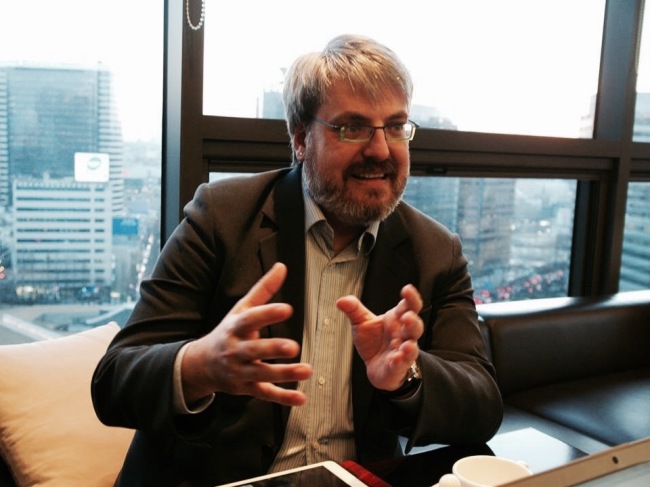Two days after the Sewol ferry sinking on April 16, 2014, took away 304 lives, mostly students on a school trip, one of the survivors was found dead in an apparent suicide.
It was the vice principal of Danwon High School in Ansan, Gyeonggi Province, where most of the student victims had attended. He left a note saying he could not bear living while over 200 of his students were still missing.
Since the Sewol tragedy, three other surviving students as well as Kim Dong-soo, 51, who saved more than 10 students’ lives in the accident, attempted suicide suffering from post-traumatic stress disorder.
These attempted suicides by the surviving passengers shed light on what is called survivors’ guilt, as well as the importance of healing the collective trauma for the Korean society to move on, said Guglielmo Schinina, head of mental health at the International Organization for Migration.
“There must have been a sense of loss, shock and guilt for survivors of the tragic accident. Koreans have built up stress over time as the incident is impossible to forget,” Schinina said in an interview with The Korea Herald in Seoul.
“But is it good strategy for the society to forget about it? I am not sure. Can you fully forget about it?” he asked. “When the event is impossible to forget, it would be better to face the suffering, make sense of it and cope with it.”
 |
| Guglielmo Schinina (IOM) |
As a renowned expert from Italy in the field of cultural integration and psychological assistance to migrants and victims of trafficking, Schinina has worked as manager of psychosocial programs, psychosocial technical advisor and trainer in more than 30 countries across the world.
He has worked to build the capacity of activists, social workers and volunteers working in war-torn countries to help traumatized migrants. His previous missions include working in postwar Lebanon in 2006, in Kenya after the postelection violence in 2008, in the aftermath of the Haiti earthquake in 2010 and more recently in Libya and Syria.
Schinina visited Korea for a two-day seminar on psychological support in emergencies hosted by the Korea office of IOM last month.
According to a 2015 survey by Korea Centers for Disease Control and Prevention, 23.9 percent of the respondents in Ansan, where Danwon high school is located, showed symptoms of anxiety in the aftermath of the tragedy. Among them, 18.4 percent said that they had considered committing suicide.
Trauma is an emotional and physical response to distressing events like deadly accidents and natural disasters. Its symptoms vary from denial, disorientation, disbelief, anger, guilt, self-blame, anxiety, insomnia, nightmares, loss of memories and depression.
“In such a situation, medication is like a life vest to save victims for a short term. But it is not a long-term solution,” he said. “Social support is as crucial as clinical support. It is important that victims are not left alone and feel connected with the society, not rejected.”
According to his years-long experience in the field, assisting tools like group therapy sessions, individual counseling and cultural activities like a role play should be activated all at the same time to more effectively support the victims.
Most importantly, there should be “space” for victims and ordinary Koreans to openly talk about the accident, express grief and feelings about it at a community level. “It can begin at community centers. Koreans should come together to resolve the trauma together.”
But the preservation of Danwon High Schools’ “memory classrooms,” which were left untouched in memory of 250 students killed in the Sweol ferry sinking, might not be the best way to help both survivors and bereaved families of student victims deal with trauma, the expert said.
Education authorities and bereaved families have clashed over whether or not to conserve them in recent months ahead of the beginning of a new semester in March. The government hopes to clear the shrine, citing a lack of classrooms for students, but the bereaved families want to maintain them to ensure the disaster is not forgotten.
“The memory classrooms bring back painful memories. It might not be a good idea to keep the classrooms in the school where other students attend every day,” he said. “Setting up an archive and memorial is really important. But it should be separated from people leading everyday lives. When people confront it every day, it is easy for them to become indifferent to it at a certain point.”
“The archive should aim to preserve positive memories about the victims to explain who they were rather than just to record the moment of their death,” he said. “What I would advise is to collect photos of victims, their drawings and diaries to remember them.”
In such cases large-scale disaster, the government’s role is also vital for members of society to get over the post-traumatic stress, he noted.
The South Korean government mapped out plans to compensate the victims and their bereaved families under the Sewol Special Act. It also established a mental health trauma center, run by Korea University Hospital, in Ansan to offer assistance and therapy to 746 bereaved families of the student victims and survivors.
But the bereaved families have lashed out for what they saw as the failure of the state to admit responsibility for the man-made disaster. They have also blamed the government’s lukewarm efforts to salvage the ferry and find the cause of the disastrous accident.
“The government should be involved closely, perhaps make an apology and restore justice in the matter, so that victims can stop blaming themselves for what happened,” he said. “It is not their fault they survived and that should be recognized. All Koreans are victims here.”
“It is a painful experience, but it is also a proof of resilience,” Schinina said. “(When it is dealt with well,) it can bring about positive results to the society as Koreans can learn from it.”
By Ock Hyun-ju (laeticia.ock@heraldcorp.com)

